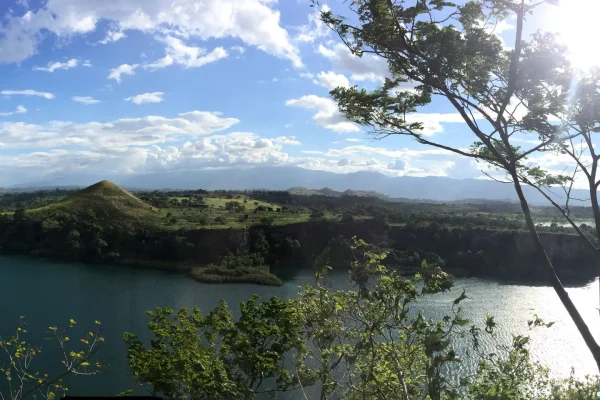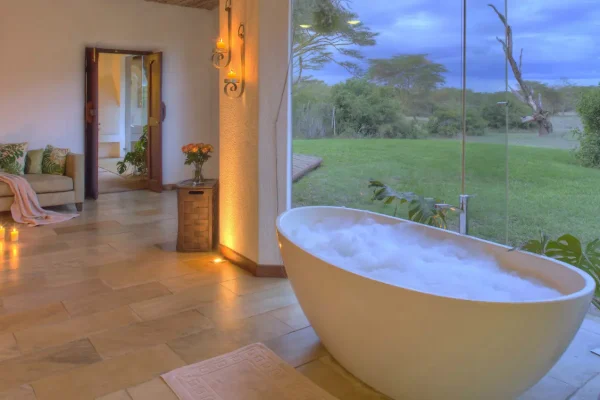Kenya vs Uganda Safaris: Which Is Better? My Honest Thoughts
Although some consider the preparation phase to be the most stressful, we contend that it is one of the most exhilarating, as it involves examining numerous destination and hotel alternatives, along with other activities in between. What occurs when you limit your options to two distinct safari experiences and find yourself unable to decide? While Kenya’s expansive grasslands and Masai culture may attract some, the profound gorilla interactions in Uganda may appeal to others.
Each site undoubtedly offers spectacular vistas, opulent lodging alternatives, captivating activities, and indelible memories; but, they represent two contrasting forms of experience.
If you find yourself indecisive, explore our assessment of a safari in Kenya versus Uganda and the unique attributes of each destination.
| Kenya | Uganda | |
| Top National Parks & Game Reserves | Masai Mara National Reserve | Bwindi Impenetrable Forest |
| Dry Seasons | January – late March | December – May, June – August |
| Wet / Green Seasons | Mid-March – June, November & December | March – May, October & November |
| Highlights (Popular Attractions) | The Great Migration.
Samburu’s leopards Combine bush-and-beach with Diani Beach or the Lamu Archipelago. The Great Rift Valley. |
Gorilla Trekking.
Nature walks & boat cruises. |
A Combination Destination: The Ultimate Kenya and Uganda Safari Sojourn
With a clear comparison established between a safari in Kenya and Uganda, it is understandable to feel further perplexed while selecting one option. Fortunately, they function effectively as combined destinations.
Since the majority of travellers enter Uganda through Nairobi, it is straightforward to design an itinerary that maximises the highlights of Kenya before proceeding to the enchanting experience of gorilla trekking, or the reverse. Rather than evaluating and selecting, amalgamate them for your most significant trip to date.
Uganda Vs Kenya Safari – Which Is Best?
The safari experiences in both Kenya and Uganda are not only remarkable but also distinctly unique. Their habitats, climates, and landscapes vary significantly; nonetheless, they share remarkable animal sightings. Given their distinctiveness, it may not be a matter of which is superior, but rather which is more suitable for you.
A Kenya safari entails visiting expansive savannahs and undulating hills while observing the remarkable herds of wildebeest as they embark on their natural journey, The Great Migration. Experience monumental river crossings as migrating herds confront the Mara River and lurking predators throughout specific months of the year. Discover Kenya’s renowned Masai Mara, the esteemed Amboseli National Park, and partake in enriching cultural activities. For individuals seeking to experience a bush and beach vacation, Kenya’s stunning coastline invites exploration.
Conversely, a Uganda safari allows explorers to navigate verdant rainforests teeming with diverse flora and animals, as well as expansive savannah-like terrains inhabited by the renowned tree-climbing lions. Twenty percent of Uganda is allocated to wildlife reserves, offering ample opportunities for exploration. Many will affirm that undertaking a gorilla trekking experience profoundly impacts the soul, in addition to the joy of encountering other primates during the journey. Depart from the lush woodlands to explore Uganda’s remarkable attractions, including Queen Elizabeth National Park, recognised as one of the most biologically varied parks globally and the nation’s foremost wildlife destination.
Although each destination possesses distinct attributes, selecting one is nearly an insurmountable task. To facilitate this conclusion, we further delineate the comparison between Kenya and Uganda:
Cost Difference Between Kenya And Uganda Safari Experiences:
It is essential to recognise that safaris are not universally applicable, particularly when collaborating with an expert who can customise an exceptional experience that aligns with your budget and aspirations. A multitude of factors effects the final figure, including, but not limited to:
- The duration of your entire safari
- Supplementary activities
- Private versus public reserves and concessions
- The seasonal period — peak versus off-peak season
- Selecting between fly-in or road transfer alternatives
- Accommodations and amenities (ranging from mid-tier to ultra-luxurious)
Kenya, a prominent safari destination in East Africa, offers a diverse range of accommodations, including camps, hotels, and mobile setups that track the migration. This signifies an increase in choices for various budgets, as well as diversity to accommodate differing preferences and values. The established reputation and popularity ensure that the infrastructure is well-developed, facilitating easy transit between parks.
Selecting a national park may be more economical; but, it entails the potential for increased visitors, particularly during the arid high season. Private reserves or concessions generally signify tailored service, exclusive game vehicles, and the chance to engage in a broader array of activities, such as walking safaris and illuminated night drives. Regarding gorilla trekking, this would be analogous to possessing a personal guide.
Landscapes & Scenery
Kenya is frequently defined by its expansive savannahs and the occasional hot-air balloon observed in the distance, with wildlife traversing the terrain beneath. Its stunning grasslands are synonymous with those immortalised by the Lion King and the timeless classic, Out of Africa. The expansive plains of the Mara provide exceptional 360-degree vistas with minimal obstruction, perfect for observing diverse animals. To the north, the terrain undulates, creating a more hilly landscape that receives less precipitation than the southern region.
To the south, Kenya borders Tanzania, and the magnificent Mount Kilimanjaro can be best viewed from Amboseli National Park. The region, benefiting from increased precipitation, boasts a vast array of species and features numerous landscapes, including wetlands, woods, and traditional savannahs. To the south and somewhat east are the beaches of Kenya, an excellent option for anyone seeking a wilderness and beach experience.
Conversely, Uganda is more solidly aligned with tropical climates and abundant vegetation. It possesses extensive and diverse landscapes, ranging from the lush Great Rift Valley and the dramatic panoramas of the Virunga Mountains to the Kazinga Channel and Uganda’s enchanting rainforests. To the west, the majestic Rwenzori Mountains are famous for experiencing episodes of snow and ice during the winter months, in sharp contrast to the temperate summers. Trekking here resembles lunar exploration due to its isolation, intriguing architecture, and profound solitude.
Similar to Kenya, Uganda is subjected to stereotyping, with the prevalent belief that it solely provides jungle-like terrains and primates. Although gorilla trekking is a prominent attraction in the country, it also boasts national parks that rival some of Africa’s best. The parks, including Queen Elizabeth, Kibale Forest, and Murchison Falls, provide exceptional wildlife observation and a diverse range of flora and fauna; for instance, Kibale National Park contains over 345 tree species, or more than 27% of the nation’s total.
Things To Do On A Kenya Vs Uganda Holiday
Regardless of whether you select a safari in Kenya or Uganda, the framework remains consistent, or at least highly comparable. A standard day on safari includes an early wake-up call and a game drive, succeeded by leisure time and lunch, before an afternoon game drive—participation in these activities is optional, allowing for the possibility of extended rest. Enhancing the experience, location and lodging dictate that nature walks led by skilled guides provide intriguing excursions, with illuminated night drives, which are restricted to specific concessions and conservancies.
A safari holiday in Kenya is significantly enhanced by a hot-air balloon ride; ascend early after dawn and observe the awakening landscape, usually culminating in a delightful bush brunch. Embark on a journey to the Mara during the Great Migration and choose to partake in a mobile camping adventure that tracks the herds from multiple bases. Additional destinations in Kenya encompass Giraffe Manor, where gentle giants coexist with humans, and it is not unusual for their heads to intrude into the breakfast area.
Uganda’s foremost attraction is clearly its gorilla trekking and monkey safaris. The remarkable Bwindi Impenetrable Forest and Mgahinga National Parks today shelter and conserve over fifty percent of the global mountain gorilla population; although sightings cannot be certain, these parks undoubtedly provide the optimal chance for encounters. Engaging with the native Batwa tribes provides enriching cultural experiences during any visit to Uganda, as they impart their customs, culture, craftsmanship, and more.
Aside from monkeys, Uganda provides traditional safaris featuring nearly all of Africa’s renowned Big 5, alongside other significant wildlife and exceptional avian diversity. Alongside game drives and guided nature walks, partake in river cruises to gain a different vantage point and observe species along the banks more closely. Uganda is a wonderland for environment enthusiasts, featuring rivers, waterfalls, forests, and lakes.
Who Is Best Suited To A Safari In Uganda Vs Kenya?
A safari in Kenya is optimal for both novice and returning tourists, as its diversity and abundance of wildlife guarantee continual intrigue. It is widely recognised that each visit to observe the Great Migration is unique; river crossings are unpredictable, and both times and sightings vary annually. The extensive array of reserves and conservancies offers exceptional opportunities for more intimate safari excursions. The nation’s appeal as a safari destination results in greater lodging diversity, facilitating the search for ideal options for families and multi-generational tourists.
An excursion to Uganda is ideal for intrepid travellers seeking to discover pristine nature and embark on foot in pursuit of wildlife encounters. Although wildlife drives and traditional safari experiences are quintessentially Ugandan, gorillas are the main attraction. It is important to acknowledge that gorilla and primate trekking has a minimum age requirement, typically set at 15 years, although this is subject to discretion. Consequently, it is not appropriate for families with younger children unless their accommodation has childcare services. Uganda, perceived as a less favoured safari destination relative to Kenya, hence experiences reduced crowds in its national parks.
Kenya Vs Uganda Safaris: Infrastructure & Accessibility
Kenya’s enduring reputation as a premier safari destination in Africa is supported by its established infrastructure and accessibility. It is noteworthy because Kenya’s international airport, Jomo Kenyatta, is in close proximity to the city, Nairobi. Smaller airports are excellent for regional and charter flights. Numerous road transfers are conducted using scheduled minibuses; Kabira Safaris Africa organises its own transportation for guests, however this remains the conventional form of transit. The majority of roads connecting safari destinations are well-maintained to accommodate self-drives and safari vehicles navigating the region.
Uganda is less developed and possesses a more rugged and unrefined ambiance. Although it is a small country, it has not yet implemented effective road maintenance systems, resulting in lengthy transit between places. This is usually intensified during the rainy season due to significant variations in weather and road conditions. Fortunately, the 4×4 game vehicles located in national parks are engineered to navigate challenging terrains with ease. During rainforest trips, knowledgeable guides and trackers will adeptly chart a secure route; all you need to provide is a quality pair of hiking boots. Although Entebbe possesses its own international airport, the majority of visitors arrive through Nairobi, the capital of Kenya.
Wildlife Guide: What Can You Expect To See?
Although sightings cannot be assured, Kenya hosts the Big 5, with certain species being particularly elusive. In straightforward terms, the likelihood of encountering elephants and buffaloes surpasses that of leopards and rhinos, especially considering their endangered status; yet, one should remain open to possibilities. The pursuit of them during game drives enhances the gratification of achievement. Seasonally, wildebeest are abundant as they traverse the plains in large herds during their annual migration. Among the herds are numerous zebras and other antelope. The Lewa Wildlife Conservancy is a premier destination for seeing rhinos and is a leader in rhino conservation in East Africa.
Departing from the prominent attractions, avian life is plentiful and exquisite in Kenya, especially near Lake Nakuru, which boasts over 400 documented species. Be vigilant for popular species such as giraffes, cheetahs, gazelles, impalas, and spotted hyenas. If your objective is to observe abundant wildlife, contemplate a visit to Amboseli National Park, where its compact dimensions and ecological diversity synergistically provide an impressive array of observations. It is essential to convey any specific ‘wishlist’ to your Africa Safari Expert and guide.
Uganda’s premier attraction is its gorilla trekking, offering an opportunity to observe one of the planet’s most elusive species. Witnessing them in their natural environment as they engage in their daily activities is an indelibly poignant experience. Bwindi Impenetrable Forest is recognised as one of Africa’s most bio-diverse forests and harbours half of the world’s remaining mountain gorilla population, establishing it as the premier destination for trekking. It also accommodates an astonishing 11 reported primate species, several animals, and remarkable avian species, with approximately 23 species native to the region.
Transitioning to the traditional safari aspect, Uganda’s parks are equally impressive, with Queen Elizabeth National Park boasting over 610 bird species, a diverse range of mammals, and opportunities for chimpanzee tracking within its woodlands. The park features an uncommon occurrence: tree-climbing lions, a behaviour usually associated with leopards, their large cat counterparts. This unusual phenomenon can be observed in a limited number of locations, with this being one of the premier sites to experience it. Access to rivers at Queen Elizabeth and Murchison Falls provides excellent observations of aquatic fauna, including hippopotamuses and crocodiles, among diverse avian and terrestrial wildlife.
Uganda Vs Kenya Accommodation Options
Kenya’s esteemed reputation and sustained popularity have provided significant opportunities for growth, especially regarding hotel possibilities. However, this does not imply that Uganda lacks products; they are generally smaller, more intimate, and maybe less opulent. Nonetheless, any deficiency in luxury is compensated by exceptional service delivered with a smile, substantial comfort, and exquisite cuisine.
Conversely, Kenya offers a plethora of choices, including mobile and permanent camps, as well as resorts that vary from comfortable to ultra-luxurious. Numerous options additionally provide stunning vistas of the surrounding landscape and local fauna. This diverse selection readily accommodates all budgets and preferences, whether one seeks a romantic honeymoon retreat, an exclusive family villa, or a traditional colonial-style camp that evokes nostalgia.
Luxury Uganda Safari Lodges
For an exceptional experience in Uganda, consider our curated lodgings and accommodations in Bwindi Impenetrable National Park, Queen Elizabeth National Park, and Kibale. Since we do not provide fixed departures, the lodges on your Uganda Safari can be entirely customised to your specifications. Whether you desire opulent living or merely seek little indulgence, we can arrange the ideal lodging for you. Explore your options below, or contact our experts for their recommendations.
Luxury Kenya Safari Lodges
Our portfolio features premier lodges in Kenya, encompassing classic, luxury, and value options for your exploration. Since we do not provide fixed departures, the lodges on your Kenya Safari can be entirely customised to your specifications. Whether you desire opulent living or merely seek little indulgence, we can arrange the ideal lodging for you. Explore your options below, or contact our experts for their recommendations.
The Best Time For A Safari In Kenya Vs Uganda
Uganda experiences two dry seasons and two wet seasons annually. Fortunately, gorilla trekking is regarded as a year-round endeavour, hence it ultimately depends on personal inclination. The majority opt to visit during the dry months—June to September and December to February—when conditions are considered more ideal. Some opt to travel during the ‘low season’—March to May and October to November—because of less crowds and enhanced cost.
The best to visit Kenya is from June to October, coinciding with the dry season when temperatures have not yet peaked. A favourable period for visitation is from January until the end of March, characterised by predominantly dry and temperate conditions. Nonetheless, some opt to travel during the rainy season — from March to June and November to December – as peak-season crowds have dissipated and off-season rates are applicable. Kenya is widely regarded as an excellent year-round destination because to its relatively temperate temperature.



